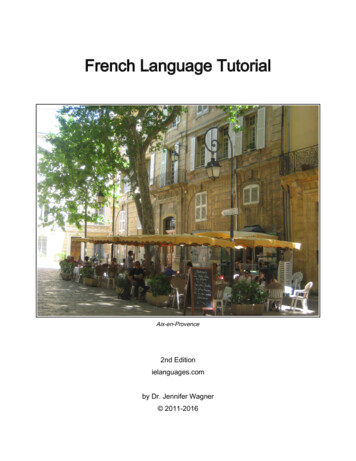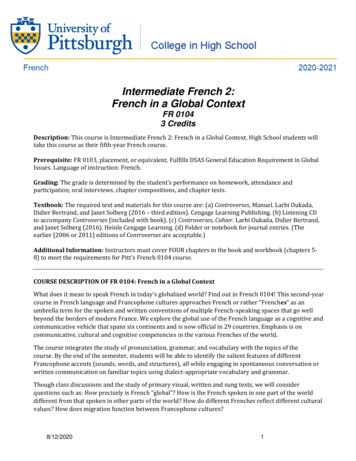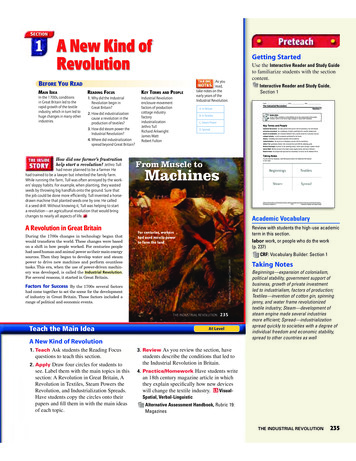
Transcription
Social Studies 20-1 – French Revolution - NotesTHE FRENCH REVOLUTION – NotesI.II.Revolution – a sudden, radical changei.Examples:Intellectual RevolutionScientific RevolutionPolitical and Social Revolutionii.Difference between revolutionary and evolutionary. Evolutionary is a process of gradual changeOld Regime was the traditional political and social system of Francethroughout the 1600’si.Characteristics:a.king is the absolute authorityb.Power is centralized in the royal bureaucracy (gov’tdepartments administer Louis XIV’s policies).c.Royal authority and rigid social structureii.First Estate: (100, 000 clergy)a.higher clergy who were nobles (live in luxury)b.parish priests – commoners (simple hardworking life) administered church, ran schools, kept birth/death records,cared for poor clergy collected tithes: taxes levied on landowners . church owned vast amounts of property (1/5 the land) onwhich they paid no taxes Services provided: Maintain religion, education, relief frompovertyiii.Second Estate: (400, 000 nobles)a.nobility (less than 2% of the population)b.enjoyed great wealth and privilege some were poor, but in defense of their traditionalprivileges would raise feudal taxes on the peasantry tocompensate for rising prices.c.special courtsd.many well paid offices reserved for nobles
Social Studies 20-1 – French Revolution - Notesiii.III.Third Estate: (26, 000, 000)a.The vast majority of French people were commonersbelonging to the Third Estate.b.Included bourgeoisie (middle class), peasants and cityworkers.c.Bourgeoisie were a small group, but the most outspoken Included merchants, manufacturers, lawyers, doctors, andshop keepers. Resented privileges of the nobles Criticized Old Regime because they believed the ideas ofthe Enlightenment – ideas of equality and social justice. Peasants made up the largest group within the Third EstateFrance’s Financial Crisis- Three factorsi.ii.iii.poor harvests hurt the economyregulations (surviving from the middle ages) hampered expansion oftrade and manufacturingmost serious economic problem – huge debt the gov’t owed bankers. Large amounts of debt from the wars of Louis XIV and XV Louis XVI continued to borrow money to maintain Versailles andto continue to fight wars in Europe Also borrowed to finance French support of the Amer. Rev.iv.Robert Turgot : first finance minister of Louis XVI Eased financial crisis by controlling gov’t spending and reducingexpenses at Versailles Recommended major tax reform – taxing the nobles Parliament were required to approve new tax laws, and since itwas made up of nobles, they rejected Turgot’s suggestion- “All public financial burdens should be borne by the lowerclasses.” Turgot dismissed by the king- In 1776 he leaves office warning theking, “Remember Sire, that it was weakness which brought thehead of Charles I to the block.”v.1786 the Banks refuse to lend more money to the French treasury.vi.1787 and 1788 poor harvests cause lack of food and worseningeconomic crisis.
Social Studies 20-1 – French Revolution - NotesIII.Stages of RevolutionStage One (Old Regime): People of Third Estate dissatisfiedwith the heavy tax burden that was becoming worse because of growingeconomic that was developing through the 1770s and 1780s.i.Due to economic crisis, Louis XVI calls the Estates General to meet inMay of 1789. Estates General: law making body before 1789 created in 1302.ii.Louis hoped to win support for his economic reforms.iii.Estates General had not met since 1614 and was unpredictablea.Reasons:Enlightenment and Philosophesiv.Structure of Estates Generala.Deputies: members of the Estates General who represent localassemblies.b.Local Assemblies drew up list of likes and dislikes calledcahiers based on ideas of philosophes and democratic ideasc.Prior to 1789, each Estate met separately and had one vote.Often led to Third Estate being outvoted 2:1. Maintainedestablishmentd.In 1789, Third Estate wants Estates General to meet togetherand each deputy to have an equal vote.d.First and Second Estate had 300 members each. Third Estatehad 600 of it’s own.v.Louis XVI locks out Third Estatevi.Tennis Court Oath (June 20, 1789)a.National Assemblyb.deputies of Third Estate, reform minded nobles, lower clergyc.swore an oath not to disband until they had written aconstitutiond.Louis XVI reluctantly orders First and Second Estates to jointheme.Peaceful first stepf.Demonstrated three Estates could meet peacefullyvii.National Assembly surrounded by troops of Louise XVIa.Third Estate fears for lives
Social Studies 20-1 – French Revolution - Notesb.Peasants see there may not be relief from inflation,unemployment, and food shortages if King crushes NationalAssemblyviii.Storming of the Bastille (July 14, 1789)The king refuses to recognize the legitimacy of the National Assembly.He assembles his royal troops near Paris. Rumors of an attack by theking, an angry national assembly and a disgruntled and hungry mobspurred the crowds to storm the royal prison. The royal troops wouldeventually side with the mob.a.Prison fortress in Paris that became a symbol of royal tyranny.b.Bastille was used primarily for housing political prisoners.c.Citizens of every class and profession, if for any reason deemedobnoxious to the royal court, were arrested by secret warrants.d.Attack on Bastille seen as an attack on the injustice andinequality of Old Regime.ix.“Great Fear”- The "Great Fear" occurred from July 20 to August 5, 1789in Fr. at the start of the Revolution . Rural unrest had been present inFrance since the worsening grain shortage of the spring, and the grainsupplies were now guarded by local militias as bands of vagrantsroamed the countryside. Rumors spread among the peasantry thatnobles had hired these vagrants to prey on villages and protect the newharvest from the peasants.In response, fearful peasants armed themselves in self-defense againstthe imaginary marauders and attacked their landlords. Landlordproperty was ransacked, and documentation recording peasantobligations were destroyed. There were isolated incidents of violenceagainst the aristocrats, but the peasants mostly wanted to destroy therecords in which the feudal dues were recorded. Grain supplies wereattacked and merchants suffered serious losses as peasants helpedthemselves to much needed supplies. The revolt spread across thecountry but gradually burned itself out as militias imposed law andorder
Social Studies 20-1 – French Revolution - NotesIV.Stage Two: Reforms of the National Assembly- a shift in power from theMonarch to the aristocratic members of the Third Estate.i.ii.iii.iv.v.August 4, 1789. Reaction to “Great Fear” leads National Assembly totake action.NA abolishes feudal customs, made all male citizens eligible forgovernment and church positionsDeclaration of the Rights of Man March 1789- basic democraticprinciples that would be the basis for the French Government.March on Versailles 1789 (October)b.Crowd led by women march on Paris to protest food pricesc.They discovered plans of the royal family to flee France andforced them to return.d.nationalistic symbols: tri-colourReligious Reformsa.freedom of worship abolish privileges of Catholic Churchb.1790, Civil Constitution of the Clergy. Gives French Gov’tcontrol of the church and allows citizens to elect bishops andpriestsc.To raise money, sells church lands which causes manyCatholics to condemn RevolutionV.Stage Three: Constitution of 1790 (Read Text pg 50)- Shift in power fromthe Aristocrats to the Bourgeoisie. Limits distinctions b/w clergy, nobles, andcommoners.a.France’s first constitutionb.Limited monarchy with King being head of executive branchc.Legislative can veto King’s veto of lawsd.Judiciary made of a series of courts. All citizens equal underlaw.e.Abolish feudal distinctions of clergy, nobles, and commonersf.France divided into 83 departmentsVI.Responses to First Three Stages of the French Revolutioni.Few people happy with constitutional Monarchyii.Division between groups of revolutionaries.a.Radical revolutionaries wanted a republicb.Monarchists thought constitution went to far.-Emigres: Nobles who fled France and urged European rulersto stop revolutionaries in France
Social Studies 20-1 – French Revolution - NotesVII.iii.Louis XVI flees in June 1791.a.arrested and brought back to Parisb.King reluctantly accepts constitution as he’s a prisoner of theAssemblyc.October 1791, Assembly meets for the first time- Left (radical, far reaching changes. Center, those with views inb/w. Right, preserve tradition)iv.Radicals split. Jacobins want rights for all male citizens to votea.Led by Maximilien Robespierreb.Jacobins become dominant in the Legislative AssemblyThe Revolution Deepensi.France at Wara.The monarchs of Europe felt uneasy because the revolutionaryideas were spreading from France to other parts of Europe.b.Felt they needed to turn back revolutionc.Revolutionary leaders want a war to unite people of France.d.Declare war on Austria, April 1792.ii.Brunswick Manifestoa.Prussian Commander, Duke of Brunswick, sends warning toParis to surrender peacefully or Austrian and Prussian troopswill burn city.b.Revolutionary leaders will be “put to the tortures theydeserve.”iii.People of Paris unafraid.a.Angrily declare that no emigres or foreign troops would crushthe revolution.b.All over France they rallied to defend the revolutioniv.Liberty, Equality, Fraternityv.Second French Revolutiona.War causes high prices and food shortages.b.Angry Parisians and sympathetic troops from the provincesjoin in an uprisingc.Aug 10, 1792 revolutionaries took over Paris City Governmentand establish new administration called the Commune.d.Revolutionary troops attack Tuileries where King and Familylivee.Royal family escapes to the Legislative Assembly for protection
Social Studies 20-1 – French Revolution - NotesVIII.Stage Four: The National Convention and the Committee of Public Safetyi.Newly elected National Convention votes to abolish the monarchy andmake France a Republic. The Reign of Terror – power shifting from thebourgeoisie to the working class.a.Radical Jacobins demand Louis be tried for treason.b.The Convention discovers letters that showed Louis wasplotting with emigres to crush the revolutionc.Louis XVI is executed.d.Later Marie-Antoinette is tried and executed for treason.ii.Because of Domestic and Foreign threats the National Convention setsaside the Constitution, approved in 1793.a.Create the Committee for Public Safetyb.Committee has nearly dictatorial power and wage a brutalcampaign against the “enemies of France.”c.Known as the Reign of Terror (July 1793 – July 1794)iii.Robespierre’s Republic of Virtuea.“our country assures the welfare of each individual and whereeach individual enjoys with pride and prosperity and the gloryof our country.”b.He believed that the state must be ruthless against its enemies.iv.Law of Suspectsa.Declared that people suspected of being counterrevolutionaries could be arrested for their conduct, theirrelations, their remarks or their writings.b.Law was vague which allowed revolutionary courts toimprison and condemn citizens on very little evidence.v.Levee en masse meant that every French Man regardless of age oroccupation was eligible to be drafted into the army.a.raise new French armies to fight in wars against neighboursvi.The Law of Maximum imposed strict limits on prices and wages.a.rationed food and outlawed use of scarce white breadb.restrictions used to bolster the economy of the countryvii.The Reign of Terror was brought to an end when the citizens startedquestioning the need for constant execution at home.a.National convention orders Robespierre’s arrest, he was tried,convicted and executed.b.With his death the Reign of Terror ended.
Social Studies 20-1 – French Revolution - NotesIX.Results of the Fourth Stage of the Revolutioni.ii.iii.iv.v.X.National Convention had abolished all remaining feudal dues andcustoms.It ended slavery in the French coloniesIt had confiscated the land of the emigresIn 1795, the National Convention wrote another constitution thatreflected the more conservative mood of the country.B/w 1789 and 1794 French life had been transformeda.monarchy was gone, king was deadb.French society was more democraticc.Equality of all peopled.All remaining feudal dues and customs were abolishede.Styles in fashion changedf.Playwrites and painters produced patriotic worksg.Metric system establishedStage Five: The Directory –Strong military leaders (Napoleon) werehelping the government control the revolutionaries. The power was shiftingback to the bourgeoisie from the working class.i.Directory included an elected legislature and an executive branch of 5directors.a. Failed because 5 man executive could not function efficiently andcorrupt deputies in the legislature bargained for political favours.b. Gov’t removed the controls on prices, so they rose sharply whichcaused poor workers to riot in Paris.ii.Napoleon found many people were dissatisfied with the Directory.a.Because of his popularity he, two directors, and his troopsoverthrew the gov’t in 1799.b.He drew up a new constitution and named himself First Consul.
Social Studies 20-1 – French Revolution - Notes III. Stages of Revolution Stage One (Old Regime): People of Third Estate dissatisfied with the heavy tax burden that was becoming worse because of growing economic that was developing through the 1770s and 1780s. i. Due to economic crisis, Lo










